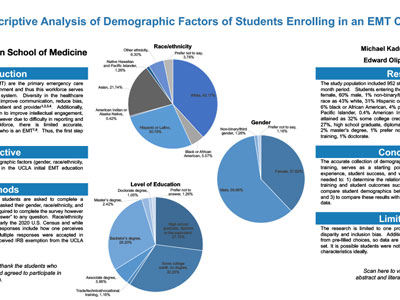ABSTRACTS
A Descriptive Analysis of Demographic Factors of Students Enrolling in an EMT CourseAuthor: Mark Cicero | | Associate Authors: Janette Baird | Kathleen Adelgais | Linda Brown | Marc Auerbach
Introduction Emergency Medical Technicians (EMT) are the primary emergency care providers in the out-of-hospital environment, and thus this workforce serves as an entry point to the healthcare system. Diversity in the healthcare workforce has been demonstrated to improve communication, reduce bias, and build the relationship between patient and provider. Additionally, diversity in education has been shown to improve intellectual engagement, motivation, and critical thinking. However due to difficulty in reporting and poor characterization of the workforce, there is limited accurate, comprehensive demographic data on who is an EMT. Thus, the first step is to start counting. Methods This is a descriptive analysis of demographic factors (gender, race/ethnicity, education) of all students enrolling in the UCLA initial EMT education program from June 2021-May 2022. As part of the enrollment process, students are asked to complete a demographic survey. Candidates are asked their gender, race/ethnicity, and level of education. All students are required to complete the survey; however, they are allowed to select “prefer not to answer” to any question. Race/Ethnicity and education responses reflect similarly the 2020 US Census and while no definition was provided, gender responses include how one perceives and/or expresses their gender. Multiple responses were accepted in choosing race/ethnicity.
Results Conclusion The accurate collection of demographic information for those entering EMT training serves a starting point for which to investigate learner experience, student success, and workforce diversity. Future research is needed to determine if diversity in the EMS training impacts outcomes.
|

